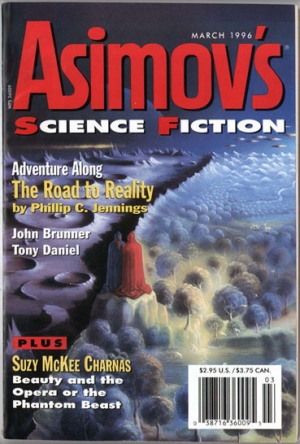Birthday Reviews: Suzy McKee Charnas’s “Beauty and the Opéra, or the Phantom Beast”

Suzy McKee Charnas was born on October 22, 1939
Charnas won the Nebula Award in 1981 for her novella “Unicorn Tapestry” and the Hugo Award in 1990 for the short story “Boobs.” She is a three time James Tiptree, Jr. Memorial Award winner for the novels Walk to the End of the World, Motherlines, and The Conqueror’s Child. Her series The Holdfast Chronicles is included in the Gaylactic Spectrum Award’s Hall of Fame and she won a Mythopoeic Award for The Kingdom of Kevin Malone.
“Beauty and the Opéra or the Phantom Beast” was originally bought by Gardner Dozois and appeared in the March 1996 issue of Asimov’s Science Fiction. Dozois reprinted it in Modern Classics of Fantasy the following year and Charnas included it in her e-collection Music of the Night and later in her collection Stagestruck Vampires and Other Phantasms. The story was nominated for the Hugo Award, the World Fantasy Award, The James Tiptree, Jr. Memorial Award, and the Theodore Sturgeon Memorial Award,
Charnas has decided to retell and expand on Gaston Leroux’s The Phantom of the Opera, conflating it with Gabrielle-Suzanne Barbot de Villeneuve’s Beauty and the Beast. While in the original story by Leroux, Christine is allowed to leave the Phantom, Erik, if she will return upon his death, in Charnas’s story, she agrees to remain with him in return for his freeing Raoul, the French nobleman she loves.
The story follows the characters as they grow to know each other in the secluded apartments Erik has created for himself beneath the Paris Opera House. With Christine agreeing to stay with the Phantom while he agrees to release Raoul, the story takes a turn into Beauty and the Beast territory with Christine suffering from Stockholm Syndrome as Erik is the only person who she can interact with. As time progresses, Christine learns how to assert herself with Erik to in effect turn the tables on him. She is still essentially his captive, but she manages to obtain a level of control over the situation and him, eventually learning that while Erik spared Raoul, he also ensured that Raoul would never mount a rescue of her.
The story not only evokes both of its sources, but also presents a tenderness and sentimentality which doesn’t become maudlin. Erik and Christine are fleshed out characters who work within the setting and situation Charnas has provided for them. The outlines of her sources are well enough known that the story works even if the reader does not have a particularly deep knowledge of them.
Reviewed in its original publication in the magazine Asimov’s Science Fiction, edited by Gardner Dozois, March 1996.
 Steven H Silver is a sixteen-time Hugo Award nominee and was the publisher of the Hugo-nominated fanzine Argentus as well as the editor and publisher of ISFiC Press for 8 years. He has also edited books for DAW and NESFA Press. He began publishing short fiction in 2008 and his most recently published story is “Webinar: Web Sites” in The Tangled Web. Steven has chaired the first Midwest Construction, Windycon three times, and the SFWA Nebula Conference 6 times, as well as serving as the Event Coordinator for SFWA. He was programming chair for Chicon 2000 and Vice Chair of Chicon 7. He has been the news editor for SF Site since 2002.
Steven H Silver is a sixteen-time Hugo Award nominee and was the publisher of the Hugo-nominated fanzine Argentus as well as the editor and publisher of ISFiC Press for 8 years. He has also edited books for DAW and NESFA Press. He began publishing short fiction in 2008 and his most recently published story is “Webinar: Web Sites” in The Tangled Web. Steven has chaired the first Midwest Construction, Windycon three times, and the SFWA Nebula Conference 6 times, as well as serving as the Event Coordinator for SFWA. He was programming chair for Chicon 2000 and Vice Chair of Chicon 7. He has been the news editor for SF Site since 2002.
(Nitpick note — fix the title spelling.)
This is one of my favorite Charnas stories.
Does the issue contain an explanation of the cover art? It was used for the final volume, That Hideous Strength, of C. S. Lewis’s superlative science fiction trilogy. I was surprised to see it here.
The art first appeared in the 1996 cover of That Hideous Strength, published the same year as this issue of Asimov’s, although I don’t know which was released first. There have been periods when Asimov’s has used previously published art in order to keep costs down, which may have been the case here.
The prior American cover for That Hideous Strength was from 1965 and painted by Bernard Symancyk.
Thanks, Steven. The artwork is certainly meant to suggest key elements of That Hideous Strength. Perhaps K. Craft retained copyright inthe art and leased it to the paperback publisher and to Asimov’s.